This list of not-so-common Herbs and Vegetables You Can Grow in Container Water Garden will tempt anyone into growing them!
Instead of growing just the regular veggies and flowers, why not try your hand at growing something different? The plants in this list can easily be started in ponds or container water gardens. Sounds doable and fun? Here are the best Herbs and Vegetables You Can Grow in a Container Water Garden.
Check out our article on creating a container water garden here.
Herbs and Vegetables You Can Grow in a Container Water Garden
1. Lotus
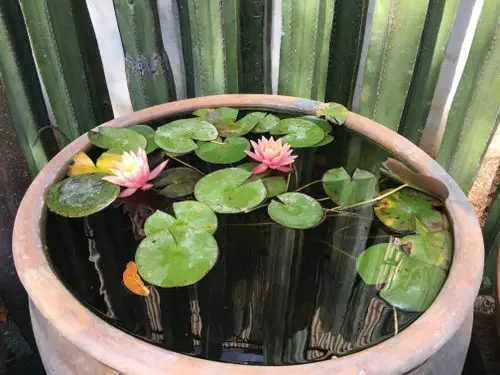
Botanical Name: Nelumbo nucifera
USDA Zone: 4-11
Lotus is a national flower of India and Vietnam. It is a common sight in water gardens and the soil of the river or pond. Almost all parts of this aquatic plant are edible. The large leaves are used as a wrap for food, while petals act as a garnishing agent.
The lotus stems are sliced and marinated in various Indian cuisines. Its seeds can be eaten like peas, and they have a sweet flavor to them.
How to Grow
Take lotus seeds and hammer the outer layer to make a crack on it. Now, drop the seeds in a glass of water and place them in bright, indirect sunlight for 4-5 days. Change the water daily until the seeds sprout.
Take a small pot and fill it with a mixture of 80% soil and 20% organic compost. Plant the seedlings in it and place the pot in a large tub and gently fill the tub completely with water, submerging the pot till it comes 2 inches above it.
Keep the container in partial shade, and you will have your lotus in no time.
2. Watermint
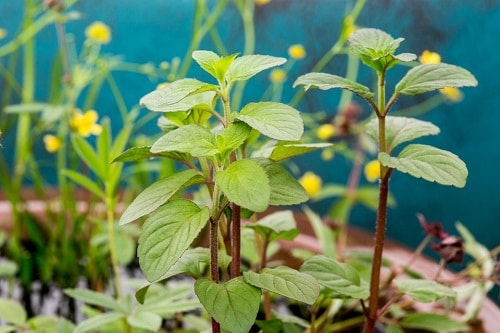
Botanical Name: Mentha aquatica
USDA Zone: 8-11
Watermint grows naturally in Northern Europe near waterways, rivers, and ditches. It has thick, deeply veined dark green leaves with a purple tinge.
The watermint has an invasive growth pattern; hence plant it in a container to control its spread. You can use it for making tea and as a flavoring agent in salads.
How to Grow
Take 10-12 inches pot, fill it with slightly acidic soil, and plant watermint cutting into it. Sink the pot into a more oversized tub filled with water.
Place at a spot where it gets full sun or partial shade. It can also be a part of your container water garden with other aquatic plants.
3. Taro

Botanical Name: Colocasia esculenta
USDA Zone: 9-11
Taro is an ornamental plant that is edible too and naturally near wetlands and ponds. However, you can easily grow it in a garden or containers for its eatable leaves and corms.
The leaves and corms of this tropical plant are edible and consumed in steamed, boiled, and baked forms across the world.
How to Grow
Take a 10-12 inches pot with a drainage hole. Fill it up with rich soil and place the taro tuber 6 inches deep in the soil.
Now lay the bucket in a tub filled with a level of water that reaches halfway to that of the bucket. Keep it at a spot that receives dappled sunlight.
4. Wasabi

Botanical Name: Eutrema japonicum
USDA Zone: 8a-10b
Wasabi is a Japanese herb native to the mountain river valley in Japan. It is served with sushi in a paste form, which is prepared from ground rhizomes.
All parts of the wasabi herb are edible; it has a somewhat similar taste to horseradish or hot mustard. It is one of the best Herbs and Vegetables You Can Grow in a Container Water Garden.
How to Grow
Deposit wasabi seeds in a Rockwool. Mist and plant it in a net cup. The seeds will germinate in 7-10 days. You can then place the seedlings in a glass of water. To know more about growing wasabi, check out our article here.
5. Water Spinach
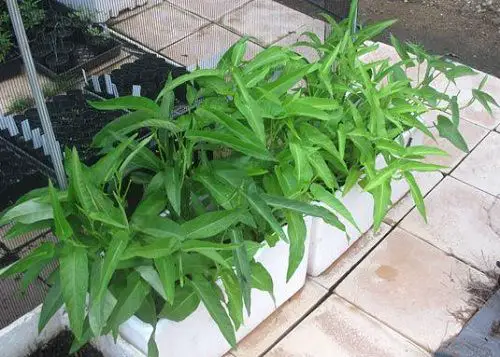
Botanical Name: Ipomoea aquatica
USDA Zone: 10-11
Also known as kangkong, this semi-aquatic plant is mainly grown in Southeast Asia. It is a creeper that grows in moist soil or water. It has ovate light green leaves and hollow stems that float on water, both of which are edible.
In tropical regions, water spinach can be harvested throughout the year, while in cool climates, you can grow it as an annual.
How to Grow
Press a few seeds in a moist Rockwool and settle it in a net cup. Once the seeds sprout and seedlings grow to 3-4 inches, you can plant them in a glass of water.
It prefers full sun and also grows in partial shade. To learn more about growing water spinach, check out our article here.
6. Watercress
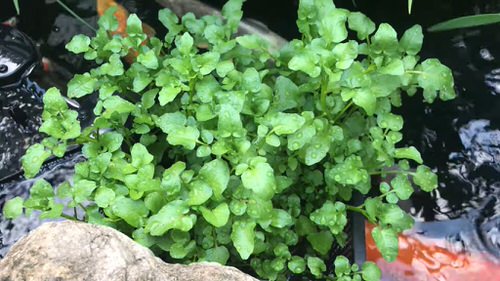
Botanical Name: Nasturtium officinale
USDA Zone: 6-9
Native to Europe and Asia, this fast-growing, semi-aquatic plant produces edible pinnate leaves and floating hollow stems. The leaves have a peppery flavor and can be consumed raw or cooked.
You can use the leaves and shoots in the preparation of salads, linguine, and tagliata. Watercress is rich in vitamin A and vitamin C and is a good source of folate.
How to Grow
Set some seeds in a Rockwool and fix it in a net cup. Place the cup in a bigger glass of water. The seeds will germinate in 5-7 days.
You can now supplement the seedlings with liquid plant food as per the instructions on the label. For more details about growing, check out this video.
7. Cattail
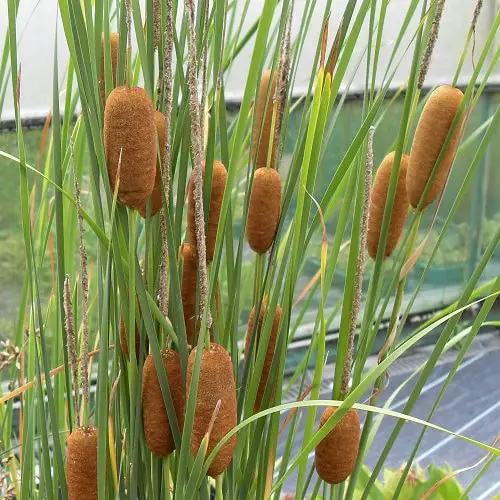
Botanical Name: Typha latifolia
USDA Zone: 3-9
Cattails are sturdy perennials that can grow up to 10 feet (2 mt) tall. The plant features rhizomatous roots and long, flat leaves with cylindrical brown flower spikes that can enhance the beauty of any water garden.
All parts of the cattail plant are edible. The roots can be boiled, roasted, or dried to make flour. After roasting, the flower heads have a nutty taste, and the middle part of the stalk is starchy and thick.
How to Grow
Plant the root in a pot filled with garden soil. Submerge the pot in a tub filled with water up to the rim. Occasionally, you can use 5 ml of seaweed solution in a gallon of water to supplement the growth.
8. Wild Rice

Botanical Name: Zizania Wildreis
USDA Zone: 5-9
Wild rice has a chewy outer cover and tender inner grain with an earthy, nutty flavor. It is not a real rice plant but a beautiful aquatic grass that is grown along with ponds, lakes, and water gardens for decoration.
The seeds are collected and eaten like rice. It grows up to 15 feet high in the wild but attains manageable length in a container.
How to Grow
Collect the seeds and stratify them before planting. Sow in a 5-gallon or larger container with regular soil blended with lots of compost and place it in a tub full of water.
Keep the water level an inch above the soil and add more when it evaporates or drops down to maintain the level. Provide at least 5-6 hours of full sun exposure.
9. Water Chestnut
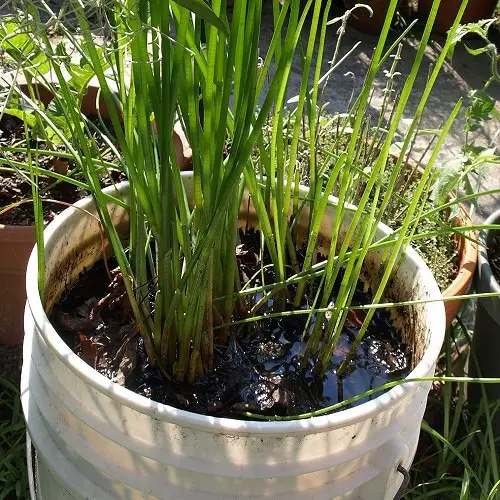
Botanical Name: Eleocharis dulcis
USDA Zone: 9-11
Native to Asia, tropical Africa, and Australia, water chestnut has small, round corms containing crisp white flesh that you can eat raw, boiled, or grilled.
It can also be tinned or pickled. Water chestnuts are also famous in noodles and rice dishes. It is one of the best Herbs and Vegetables You Can Grow in Container Water Garden.
How to Grow
It is easy to grow in a balcony garden too. Get about a foot long water chestnut plant from a nursery. Take a medium-sized tub/ bucket and fill its bottom 1/4 part with a good quality potting mix.
Position the plants and water until the soil is submerged about an inch to mimic the rice paddy field-effect—place at a sunny location.
10. Water Pepper
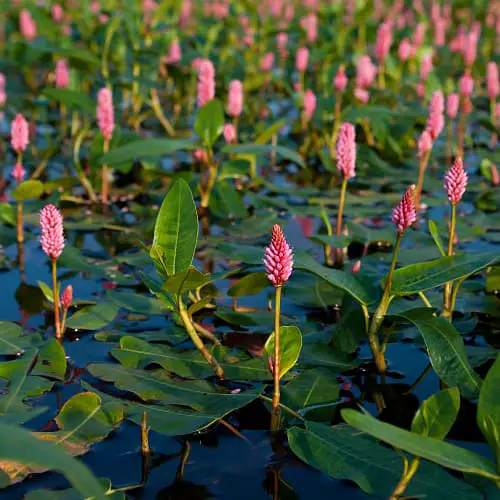
Botanical Name: Persicaria amphibia
USDA Zone: 5-9
Also known as marsh pepper and knotweed, water pepper grows in damp areas and shallow water. It is also famous as a spice due to its pungent flavor.
The leaves are widely used in fish dishes in Japan, whereas dry leaves are famous as condiments in Southeast Asia.
How to Grow
Take a pot and fill it up with a potting mix. Sow the seeds 2 inches deep and water well. Place the pot/bottle at a shaded spot, and the seeds will germinate in 5-7 days. The plant will get ready for harvest in 55-60 days.
11. Skirret Carrot
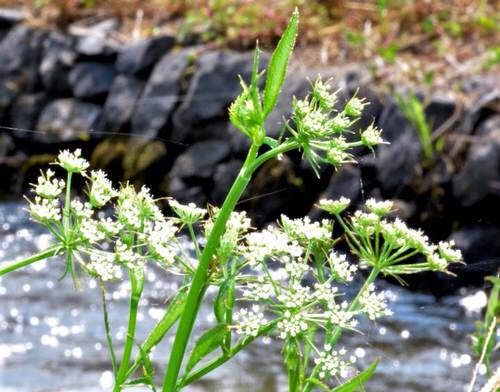
Botanical Name: Sium sisrum
USDA Zones: 5-9
Native to China, the skirret carrot was a favorite of Emperor Tiberius. It is related to carrots and has skinny white edible roots that taste like parsnip. It also has a sweet flavor.
How to Grow
Plant skirret during spring when the danger of frost has passed. Use a large container, fill it with rich organic matter in loamy or sandy soil, and sink the container into a large tub filled with water till it gets fully submerged—place in full sun.
12. Marsh Marigold
Botanical Name: Caltha palustris
USDA Zones: 3-7
Marsh marigold is edible when cooked appropriately. When eaten raw, it can cause swelling and irritation of the mouth, so avoid it at all costs.
How to grow
It grows best in humus-rich, muddy soil as naturally, it is found near the borders of rivers, streams, and ponds. Fill the pot with rich, damp soil to cover the roots. Sink the container in a large tub filled with water and place it in an area that gets full sunlight.
13. Tanier Spinach

Botanical Name: Xanthosoma brasilense
USDA Zones: 9-11
It is one of the important food crops that originated in the Amazonian region of South America. This vegetable is the main ingredient in the famous West Indian stew known as ‘Calalu.’ The leaves are loaded with vitamin A and C!
How to Grow
This wetland plant likes a wet and warm environment and prefers constantly moist soil. Grow it in a large container filled with regular potting soil and submerge it in a tub full of water. You can also grow it around your garden pond.



